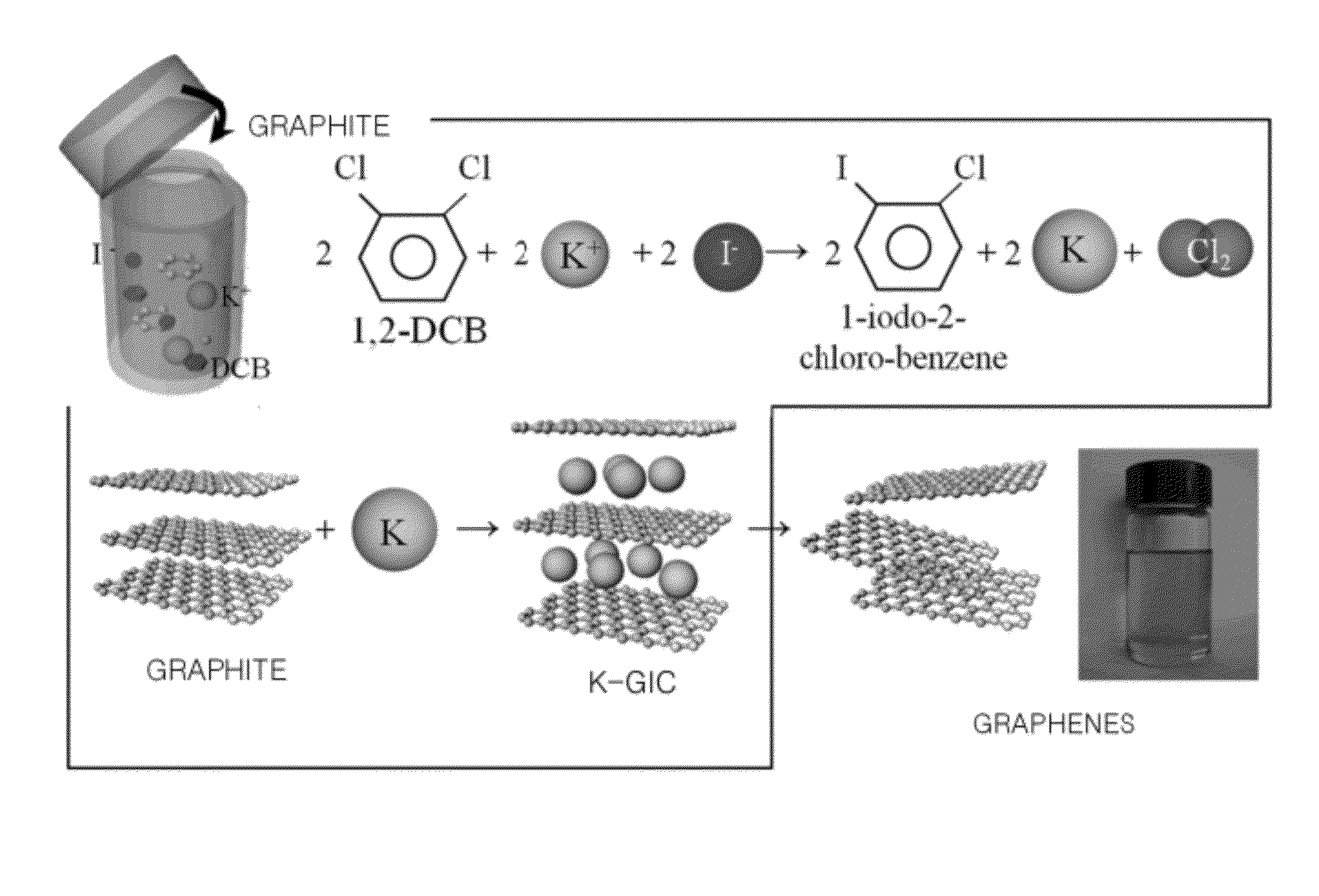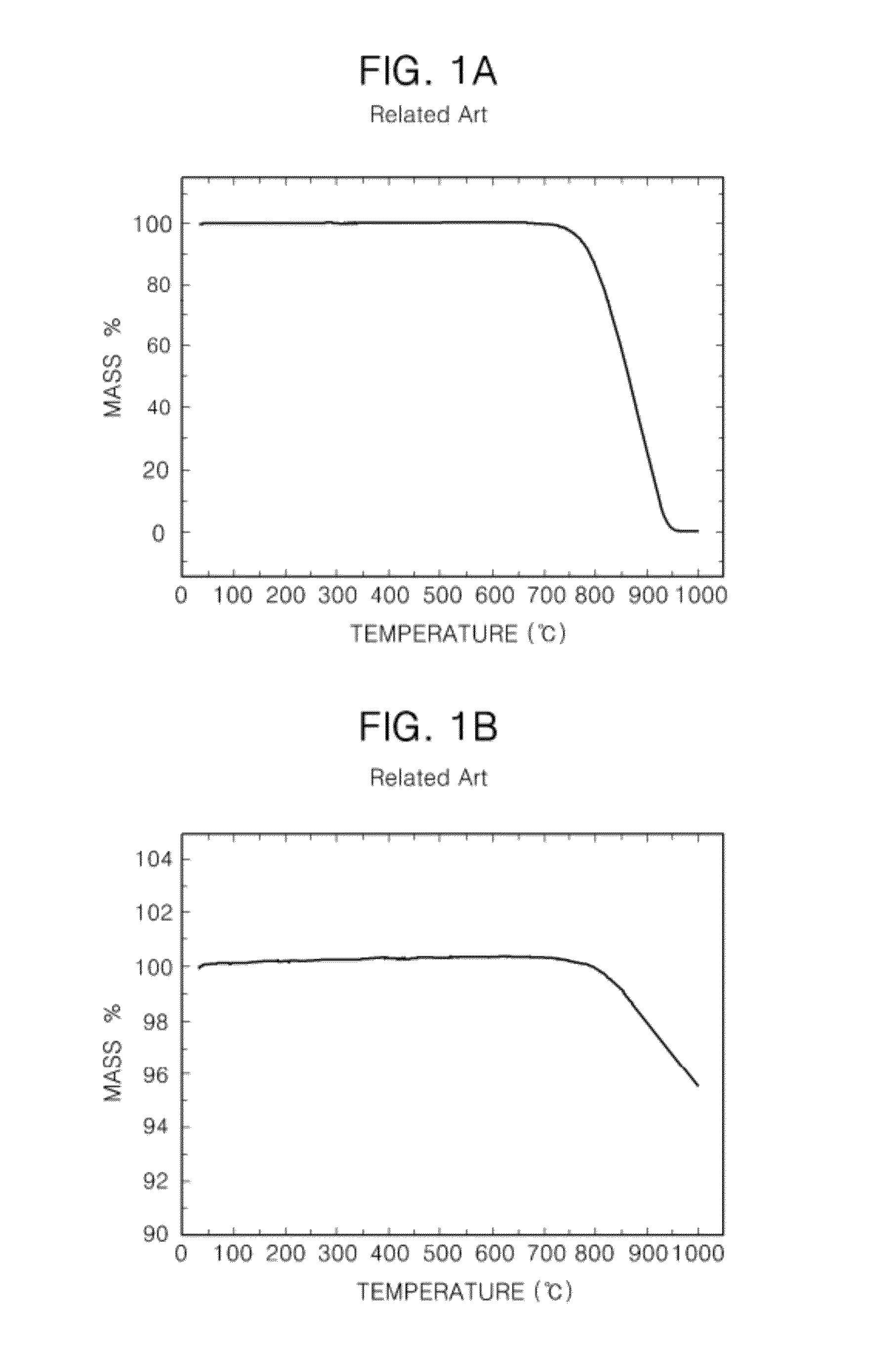Method for producing graphenes through the production of a graphite intercalation compound using salts
a technology of intercalation compound and graphene, which is applied in the direction of graphene, nano-carbon, and nano-materials, etc., can solve the problems of high cost, high cost, and uneven shape of detached graphene sheets, and achieve high quality, high-quality graphene, and reduced price
- Summary
- Abstract
- Description
- Claims
- Application Information
AI Technical Summary
Benefits of technology
Problems solved by technology
Method used
Image
Examples
first experimental example
[0083]In the present experimental example, K ions as alkaline metals were selected as ions to be inserted in intercalation of graphite, and a salt mixture of KI and KOH was used as alkaline metal salts to provide K ions.
[0084]FIG. 9 is a graph showing phases of KI and KOH. In FIG. 9, when two or more salts were mixed at a predetermined mole ratio, the melting point of the salt mixture was lowered. Since KI and KOH each have a low eutectic point of 250° C., as shown in FIG. 9, by heating KI and KOH at a temperature of 250° C. or higher at an eutectic point mole ratio, graphite may be dispersed without adding a solvent to the KI and KOH.
[0085]FIG. 10A is a photo showing the case that KI, KOH, and highly oriented pyrolytic graphite (HOPG) pieces were put in a capsulated container and were heated at 250° C. and then the capsulated container was opened. In FIG. 10A, since the HOPG pieces were dispersed, the graphene was produced. FIG. 10B is a photo showing the case that THF was put in K...
second experimental example
[0088]In the second experimental example, a salt mixture of KI and KCl was used as alkaline metal salts to provide K ions.
[0089]Since KI and KCl each have a high eutectic temperature of 599° C., as shown in FIG. 12, graphite cannot be dispersed only using salts; however, two salts were dissolved in dichlorobenzene (DCB) and then were heated and thus graphite was dispersed.
[0090]A specific process is as follows. When KI, KCl, DCB, and graphite were put in a container and the container was capsulated, the capsulated container was heated at 250° C. so as to produce a K-GIC. After that, when the K-GIC was put in ethanol, inserted K was removed, and the graphene was produced.
[0091]When salts were dissolved in a solvent, the salts exist as positive ions and negative ions and are neutral in an electrical aspect. Although a reaction in which alkaline metals are inserted in intercalation of graphite is a voluntary reaction, K+ cannot be inserted in intercalation of graphite while an electric...
third experimental example
[0100]In the third experimental example, the graphene was produced by obtaining alkaline metals from alkaline metal salts. K was selected as alkaline metals to be inserted in intercalation of graphite, and a reaction between KI as alkaline metal salts and DCB as a solvent K was used in order to obtain K.
[0101]First, FIG. 19 is a view of a method for producing graphene according to the present experimental example.
[0102]As shown in FIG. 19, KI, DCB, and graphite were put in a container, and the container was capsulated, and the capsulated container was heated at 300° C. 1-iodo-2-chloro-benzene, and K and Cl2 were obtained through a reaction between KI and DCB. K was inserted in intercalation of graphite so as to produce a K-GIC. After that, when the K-GIC is put in ethanol, inserted K was removed, and the K-GIC was dispersed, and thus the graphene was produced.
[0103]Gas chromatography / mass spectroscopy was performed in order to check whether 1-iodo-2-chloro-benzene is actually formed...
PUM
 Login to View More
Login to View More Abstract
Description
Claims
Application Information
 Login to View More
Login to View More - R&D
- Intellectual Property
- Life Sciences
- Materials
- Tech Scout
- Unparalleled Data Quality
- Higher Quality Content
- 60% Fewer Hallucinations
Browse by: Latest US Patents, China's latest patents, Technical Efficacy Thesaurus, Application Domain, Technology Topic, Popular Technical Reports.
© 2025 PatSnap. All rights reserved.Legal|Privacy policy|Modern Slavery Act Transparency Statement|Sitemap|About US| Contact US: help@patsnap.com



